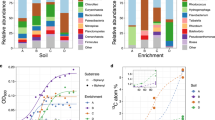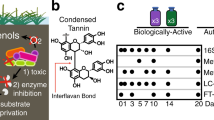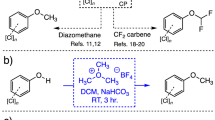Abstract
Using proteins from soil or groundwater as functional biomarkers requires efficient extraction. We developed an extraction method in which the separation of proteins from the inorganic and organic constituents of the soil matrix was achieved by a combination of 0.1 M NaOH treatment and phenol extraction. Incubation with NaOH released humic acids and proteins from soil minerals, and simultaneously, disrupted microorganisms. The subsequent phenol extraction separated the proteins from the humic organic matter. Protein extracts were applied to sodium dodecyl sulfate polyacrylamide gel electrophoresis (SDS-PAGE) and 2D-electrophoresis (2-DE). Spots and bands were excised and individual proteins identified by liquid chromatography online linked to mass spectrometry (MS) via electrospray ionization source (LC-ESI-MS). To assess the suitability of the method for the functional analysis of environmental metaproteomes, it was applied to soil that had been enriched in chlorophenoxy acid-degrading bacteria by incubation with 2,4-dichlorophenoxy acetic acid (2,4-D) for 22 days. The method was also used to analyze groundwater from the aquifer of a chlorobenzene-contaminated site. The identification of enzymes such as chlorocatechol dioxygenases was consistent with bacterial metabolic pathways expected to be expressed in these samples. The protocol enabled thus the analysis of the metaproteome of soil and groundwater samples. It thereby provides a means to study the diversity of environmental microbial communities while addressing functional aspects more directly than metagenome or even metatranscriptome analysis.
Similar content being viewed by others
Log in or create a free account to read this content
Gain free access to this article, as well as selected content from this journal and more on nature.com
or
References
Alfreider A, Vogt C, Babel W . (2002). Microbial diversity in an in situ reactor system treating monochlorobenzene contaminated groundwater as revealed by 16S ribosomal DNA analysis. Sys Appl Microbiol 25: 232–240.
Aoyama M . (2006). Properties of neutral phosphate buffer extractable organic matter in soils revealed using size exclusion chromatography and fractionation with polyvinylpyrrolidone. Soil Sci Plant Nutr 52: 378–386.
Balcke GU, Turunen LP, Geyer R, Wenderoth DF, Schlosser D . (2004). Chlorobenzene biodegradation under consecutive aerobic-anaerobic conditions. FEMS Microbiol Ecol 49: 109–120.
Benndorf D, Thiersch M, Loffhagen N, Kunath C, Harms H . (2006). Pseudomonas putida kt2440 responds specifically to chlorophenoxy herbicides and their initial metabolites. Proteomics 6: 3319–3329.
Boschker HTS, Nold SC, Wellsbury P, Bos D, de Graaf W, Pel R et al. (1998). Direct linking of microbial populations to specific biogeochemical processes by c-13-labelling of biomarkers. Nature 392: 801–805.
Chen P, Nie S, Mi W, Wang XC, Liang SP . (2004). De novo sequencing of tryptic peptides sulfonated by 4-sulfophenyl isothiocyanate for unambiguous protein identification using post-source decay matrix-assisted laser desorption/ionization mass spectrometry. Rapid Comm Mass Spectrom 18: 191–198.
Criquet S, Farnet AM, Ferre E . (2002). Protein measurement in forest litter. Biol Fertil Soils 35: 307–313.
Eilers H, Pernthaler J, Glockner FO, Amann R . (2000). Culturability and in situ abundance of pelagic bacteria from the north sea. Appl Environ Microbiol 66: 3044–3051.
Fields MW, Bagwell CE, Carroll SL, Yan T, Liu X, Watson DB et al. (2006). Phylogenetic and functional biomakers as indicators of bacterial community responses to mixed-waste contamination. Environ Sci Tech 40: 2601–2607.
Fredrickson JK, Mckinley JP, Nierzwickibauer SA, White DC, Ringelberg DB, Rawson SA et al. (1995). Microbial community structure and biogeochemistry of miocene subsurface sediments – implications for long-term microbial survival. Mol Ecol 4: 619–626.
Görg A, Postel W, Gunther S . (1988). The current state of two-dimensional electrophoresis with immobilized ph gradients. Electrophoresis 9: 531–546.
Guerlava P, Izac V, Tholozan JL . (1998). Comparison of different methods of cell lysis and protein measurements in Clostridium perfringens: application to the cell volume determination. Curr Microbiol 36: 131–135.
Kan J, Hanson TE, Ginter JM, Wang K, Chen F . (2005). Metaproteomic analysis of chesapeake bay microbial communities. Saline Systems 1: 7.
Kanagawa T . (2003). Bias and artifacts in multitemplate polymerase chain reactions (pcr). J Biosci Bioeng 96: 317–323.
Kirby KS . (1956). New method for the isolation of ribonucleic acids from mammalian tissues. Biochem J 64: 405–408.
Kleinsteuber S, Riis V, Fetzer I, Harms H, Muller S . (2006). Population dynamics within a microbial consortium during growth on diesel fuel in saline environments. Appl Environ Microbiol 72: 3531–3542.
Klose J . (1975). Protein mapping by combined isoelectric focusing and electrophoresis of mouse tissues – novel approach to testing for induced point mutations in mammals. Humangenetik 26: 231–243.
Krooneman J, Moore ERB, van Velzen JCL, Prins RA, Forney LJ, Gottschal JC . (1998). Competition for oxygen and 3-chlorobenzoate between two aerobic bacteria using different degradation pathways. FEMS Microbiol Ecol 26: 171–179.
Kukor JJ, Olsen RH . (1996). Catechol 2,3-dioxygenases functional in oxygen-limited (hypoxic) environments. Appl Environ Microbiol 62: 1728–1740.
Lacerda CMR, Choe LH, Reardon KF . (2007). Metaproteomic analysis of a bacterial community response to cadmium exposure. J Proteome Res 6: 1145–1152.
Laemmli UK . (1970). Cleavage of structural proteins during assembly of head of bacteriophage-T4. Nature 227: 680–685.
Landi L, Renella G, Moreno JL, Falchini L, Nannipieri P . (2000). Influence of cadmium on the metabolic quotient, l-: D-glutamic acid respiration ratio and enzyme activity: microbial biomass ratio under laboratory conditions. Biol Fertil Soils 32: 8–16.
Lo I, Denef VJ, VerBerkmoes NC, Shah MB, Goltsman D, DiBartolo G et al. (2007). Strain-resolved community proteomics reveals recombining genomes of acidophilic bacteria. Nature 446: 537–541.
Manefield M, Griffiths R, Bailey M, Whiteley A . (2006). Stable Isotope Probing: A Critique of its Role in Linking Phylogeny and Function, 1st edn. Springer: Berlin.
Moreno JL, Garcia C, Landi L, Falchini L, Pietramellara G, Nannipieri P . (2001). The ecological dose value (ed50) for assessing cd toxicity on atp content and dehydrogenase and urease activities of soil. Soil Biol Biochem 33: 483–489.
Muller RH, Babel W . (1986). Glucose as an energy donor in acetate growing acinetobacter-calcoaceticus. Arch Microbiol 144: 62–66.
Nannipieri P . (2006). Role of Stabilised Enzymes in Microbial Ecology and Enzyme Extraction from Soil with Potential Applications in Soil Proteomics, 1st edn. Springer: Berlin.
Nestler H, Kiesel B, Kaschabek SR, Mau M, Schlomann M, Balcke GU . (2007). Biodegradation of chlorobenzene under hypoxic and mixed hypoxic-denitrifying conditions. Biodegrad (published online doi:10.1007/s10532-007-9104-z).
O'Farrell PH . (1975). High-resolution 2-dimensional electrophoresis of proteins. J Biol Chem 250: 4007–4021.
Ogunseitan OA . (2006). Soil Proteomics: Extraction and Analysis of Proteins from Soils, 1st edn. Springer: Berlin.
Oh KH, Tuovinen OH . (1990). Degradation of 2,4-dichlorophenoxyacetic acid by mixed cultures of bacteria. J Ind Microbiol 6: 275–278.
Radajewski S, Ineson P, Parekh NR, Murrell JC . (2000). Stable-isotope probing as a tool in microbial ecology. Nature 403: 646–649.
Ram RJ, VerBerkmoes NC, Thelen MP, Tyson GW, Baker BJ, Blake RC et al. (2005). Community proteomics of a natural microbial biofilm. Science 308: 1915–1920.
Rhee SK, Liu XD, Wu LY, Chong SC, Wan XF, Zhou JZ . (2004). Detection of genes involved in biodegradation and biotransformation in microbial communities by using 50-mer oligonucleotide microarrays. Appl Environ Microbiol 70: 4303–4317.
Rigou P, Rezaei H, Grosclaude J, Staunton S, Quiquampoix H . (2006). Fate of prions in soil: adsorption and extraction by electroelution of recombinant ovine prion protein from montmorillonite and natural soils. Environ Sci Technol 40: 1497–1503.
Samyn B, Sergeant K, Memmi S, Debyser G, Devreese B, Van Beeumen J . (2006). Maldi-tof/tof de novo sequence analysis of 2-d page-separated proteins from Halorhodospira halophila, a bacterium with unsequenced genome. Electrophoresis 27: 2702–2711.
Santos PM, Benndorf D, Sa-Correia I . (2004). Insights into Pseudomonas putida KT2440 response to phenol-induced stress by quantitative proteomics. Proteomics 4: 2640–2652.
Schulze WX, Gleixner G, Kaiser K, Guggenberger G, Mann M, Schulze ED . (2005). A proteomic fingerprint of dissolved organic carbon and of soil particles. Oecologia 142: 335–343.
Simonart P, Batistic L, Mayaudon J . (1967). Isolation of protein from humic acid extracted from soil. Plant Soil 27: 153–161.
Singleton I, Merrington G, Colvan S, Delahunty JS . (2003). The potential of soil protein-based methods to indicate metal contamination. Appl Soil Ecol 23: 25–32.
Stevenson FJ . (1982). Humus Chemistry – Genesis, Composition, Reactions. Wiley: New York.
van der Meer JR, Werlen C, Nishino SF, Spain JC . (1998). Evolution of a pathway for chlorobenzene metabolism leads to natural attenuation in contaminated groundwater. Appl Environ Microbiol 64: 4185–4193.
Vance ED, Brookes PC, Jenkinson DS . (1987). An extraction method for measuring soil microbial biomass-C. Soil Biol Biochem 19: 703–707.
Vogt C, Alfreider A, Lorbeer H, Hoffmann D, Wuensche L, Babel W . (2004). Bioremediation of chlorobenzene-contaminated ground water in an in situ reactor mediated by hydrogen peroxide. J Contam Hydrol 68: 121–141.
Wagner M, Nielsen PH, Loy A, Nielsen JL, Daims H . (2006). Linking microbial community structure with function: fluorescence in situ hybridization-microautoradiography and isotope arrays. Curr Opin Biotechnol 17: 83–91.
Wang W, Scali M, Vignani R, Spadafora A, Sensi E, Mazzuca S et al. (2003). Protein extraction for two-dimensional electrophoresis from olive leaf, a plant tissue containing high levels of interfering compounds. Electrophoresis 24: 2369–2375.
Wilmes P, Bond PL . (2004). The application of two-dimensional polyacrylamide gel electrophoresis and downstream analyses to a mixed community of prokaryotic microorganisms. Environ Microbiol 6: 911–920.
Wilmes P, Bond PL . (2006). Metaproteomics: studying functional gene expression in microbial ecosystems. Trends Microbiol 14: 92–97.
Zhou JH . (2003). Microarrays for bacterial detection and microbial community analysis. Curr Opin Microbiol 6: 288–294.
Author information
Authors and Affiliations
Corresponding author
Additional information
Supplementary Information accompanies the paper on The ISME Journal website (http://www.nature.com/ismej")
Rights and permissions
About this article
Cite this article
Benndorf, D., Balcke, G., Harms, H. et al. Functional metaproteome analysis of protein extracts from contaminated soil and groundwater. ISME J 1, 224–234 (2007). https://doi.org/10.1038/ismej.2007.39
Received:
Revised:
Accepted:
Published:
Issue date:
DOI: https://doi.org/10.1038/ismej.2007.39
Keywords
This article is cited by
-
Soil metaproteomics as a tool for monitoring functional microbial communities: promises and challenges
Reviews in Environmental Science and Bio/Technology (2020)
-
Taxonomic and functional characterization of a microbial community from a volcanic englacial ecosystem in Deception Island, Antarctica
Scientific Reports (2019)



